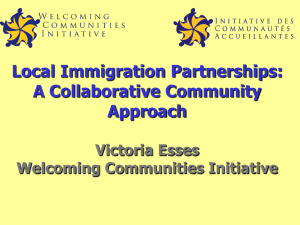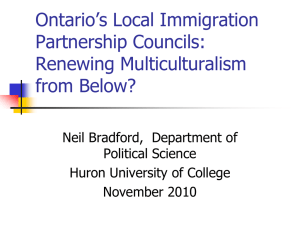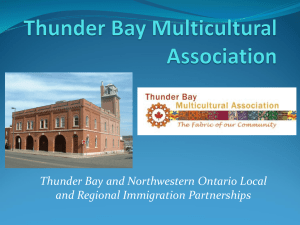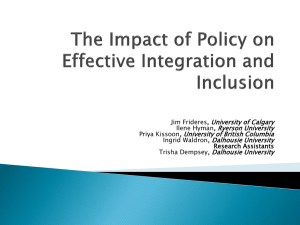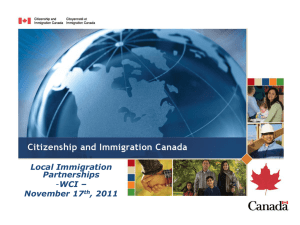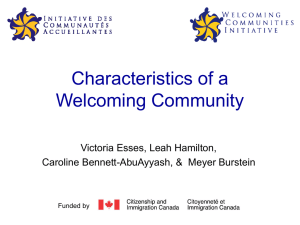here. - Association for New Canadians
advertisement
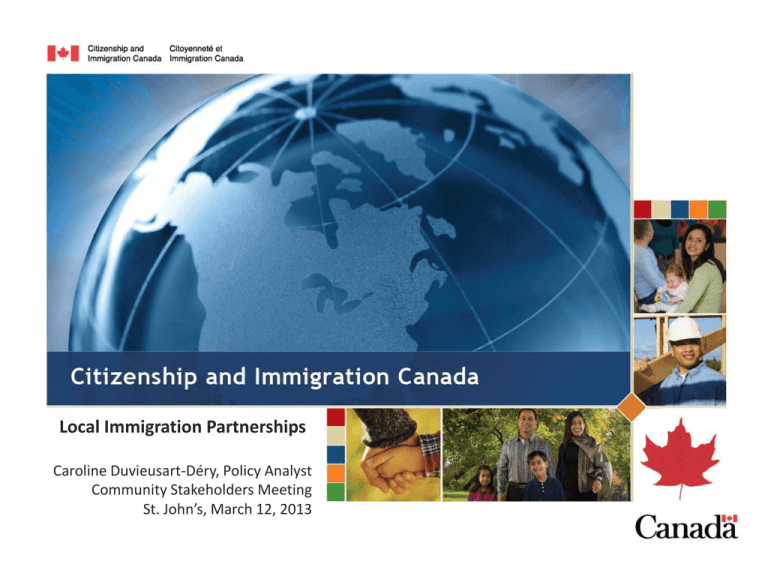
Local Immigration Partnerships Caroline Duvieusart-Déry, Policy Analyst Community Stakeholders Meeting St. John’s, March 12, 2013 Outline of the presentation • Welcoming communities and federal government policy – Fostering welcoming communities: a local reality – Federal commitment and the Local Immigration Partnerships • Local Immigration Partnerships – – – – – – • Current LIPs A flexible approach to local contexts Key expected results of the LIPs Steps in the LIPs process Typical structure of the LIPs Scope of engagement What have we learned? – Examples of success – LIPs best practices – Opportunities the LIPs present • Four elements of CIC’s vision for the LIPs • For more information 2 Fostering welcoming communities: a local reality • Since the mid-1990s, CIC has increasingly recognized the importance of engagement at the local level. – Municipalities play a central role in delivering some services that impact the settlement and integration experiences of newcomers. – Tremendous capacity and expertise exist at the local level. – Economic benefits of immigration are most evident in the local context. – Attraction of newcomers is only useful if the retention challenge is resolved. • Municipalities and communities are taking a greater role in planning for and guiding immigration and settlement. – Attraction: Newcomers can play a critical role in addressing emerging labour market needs. – Retention: Entire families need to feel welcomed for workers to stay. • There is ongoing and growing appetite for engagement: new initiatives and successful partnerships can be observed throughout the country. – – – – – Federation of Canadian Municipalities: Quality of Life Francophone Minority Communities: Francophone Immigration Networks UNESCO: Cities Against Racism Maytree: Cities of Migration Welcome BC: Welcoming Communities Program 3 Federal commitment and the Local Immigration Partnerships • Existing community partnerships include a wide range of planning practices varying in complexity and intensity according to organizational size and resources. • CIC is committed to fostering welcoming communities in collaboration with local stakeholders. Its approach is to support the Local Immigration Partnerships, which consist in a flexible but systematic model: engage, consult, develop strategy and action plans and improve outcomes for newcomers. What are the Local Immigration Partnerships (LIPs)? • The LIPs are indirect services that bring about a new form of collaboration at the community-level related to newcomer settlement and integration. They aim at: – Systematizing local engagement in and awareness of newcomers’ integration process; – Supporting community-level research and strategic planning; – Improving coordination of effective services that facilitate immigrant settlement and integration (SPOs and mainstream institutions). • Being structural and not task-specific, they are capable of serving a multitude of ends through a collaborative approach with a wide variety of local stakeholders interested in settlement and integration. 4 Current LIPs • The Canada-Ontario Immigration Agreement generated the right conditions for creating the LIPs by explicitly including municipal engagement in the formal agreement. • The first LIPs were created in Ontario starting in 2008. CIC currently funds 35 LIPs in Ontario, and has started expanding the initiative to other provinces. The Calgary Local Immigration Partnership was the first LIP to be launched outside of Ontario, in May 2012. Different types of organizations hold the LIP contribution agreement with CIC. Some LIPs are co-chaired by the municipality and a community organization. 2 3 Municipal, Regional or County Administration 5 17 Immigrant/Multicultural Association Economic or Labour Force Association Other 13 Umbrella Organization 5 A flexible approach to local contexts • The LIP model allows for significant levels of variation and can be adapted to local specificities, both contextual and strategic. Geographic scale Regional municipality, county, group of counties Municipality, neighbourhood Demographics High population density High immigration Low population density Few newcomers Immigration goals Attraction and retention Integration and management of diversity Key issues Employment, filling labour market gaps Social issues, housing, health, discrimination Focus Broad: newcomers, cultural diversity Targeted: initiatives for specific ethnocultural populations 6 Key expected results of the LIPs Newcomers’ needs identified Community assets and gaps mapped Relevant strategy and action plans developed on the basis of newcomers needs and the assets and gaps mapping Services coordinated at the community level Adapted programming and service delivery by nonsettlement institutions Improved accessibility of newcomers to services and enhanced uptake LIPs secured resources from diverse sources Feed into Settlement Program outcomes Partnership allows for crosssector collaboration Partners have the tools to become more welcoming Newcomers find employment commensurate with their skills and experience (from Settlement Program Logic Model) Partnership council allows for meaningful engagement of a diversity of members Newcomers enjoy their rights and act on their responsibilities in Canadian society Canadians provide a welcoming community to facilitate the full participation of newcomers Newcomers contribute to the economic, social and cultural development needs ofCanada Sustaining partnerships at the community level 1-2 years 3-5 years 5+ years Build capacity Effect community change Improve outcomes for newcomers Immediate outcomes Intermediate outcomes Ultimate outcomes 7 Steps in the LIPs process 5. Implement the action plan annually 4. Develop an annual action plan to address local priorities 3. Conduct research and establish a local settlement strategy to be implemented over three years 2. Create terms of reference for the partnership council 1. Establish a partnership council Assess progress and measure outcomes 8 Typical structure of a LIP LIPs are steered by broad-based coordinating councils tasked with overall stewardship and management control over initiatives such as needs assessments and asset mapping of their community. LIP Council Working Groups or Sector Tables focus on particular sectors of interest or need in the community. Common themes include employment, language training, social inclusion, settlement, health or youth. Some LIPs have created Action Teams to work on specific projects emerging from a Working Group. These teams are most relevant at the implementation phase. Working Group Action Team Working Group Action Team Working Group LIP Secretariat Executive Committee Some LIPs have created Steering or Executive Committees to support them in this work. A staffed secretariat facilitates the LIP’s work by coordinating and providing organizational support. Action Team 9 Scope of engagement Representation on LIP councils • Government representative • Schools/School boards • Umbrella organizations • Newcomers (individuals) • Mainstream and ethnic media • Housing services • Settlement service providers • Hospitals/Health units • Civil society groups • Francophone organizations • Language training providers • Children/Family services • Employer bodies/Employers • Justice/Policy • Universities/Research networks • Ethnocultural/Religious org. • Public libraries • Other Themes covered in LIPs strategies 25 20 15 10 5 0 10 Commonalities within LIP priorities Common Themes Priorities Newcomer attraction, retention and business development • Mentoring Programs and internships • Enhanced Language Training • Employment and business information services Children and Youth • Social integration throuh activities conducted by mainstream organizations • Improving information provided to newcomers parents about their children’s educational opportunities and experiences Community civic resources • Public transportation • Services for immigrant women and seniors Education and education policy • English Language training • Improving education supports and coordination of educational services • Fostering cultural competence in schools Health and healthcare • Improving mental health • Removing systematic barriers to care and promoting cultural competency • Enhancing health literacy Social, cultural and political inclusion • Improving access and content of information about community services • Increasing newcomer civic engagement • Reducing racism and lack of cultural understanding in the host community Workplace integration • Recruitment and bridging programs • Recognition of international credentials • More receptive organizational culture 11 Examples of success Outcome Examples of success LIP expands the diversity of members engaged in settlement and facilitates collaboration. • Growing interest from community members in joining the LIPs and collaborating to implement new services. • A variety of community stakeholders (including the municipal government) are endorsing the vision and strategies developed by the LIPs. • Members are contributing significant in-kind suport to ensure success of LIP activities. Better understanding of newcomers needs and community’s assets and gaps. • Consultations and research included a wide range of newcomers, including those having not accessed settlement services. • Creation of detailed mapping of settlement and mainstream service gaps. • Community forums and LIP events are raising awareness of newcomers needs. • Immigrant profiles present the unique needs and contributions of newcomers. Programming and service delivery by mainstream institutions is adapted to newcomer needs. • LIPs influenced municipal governments to create positions focusing on immigration and the newcomer population. • Collaboration with employers to identify and replicate inclusive hiring practices. • LIP members champion projects facilitating newcomers’ access to health or education services, replicate best practices across sectors. • Service providers offer training to mainstream institutions to better serve newcomers. Services are better coordinated at the community level. • Agencies collaborate to develop grant proposals for new programs or services, minizing competition and avoiding duplication. • Increasing number and quality of referrals between LIP partners. • LIP becomes a forum for exchange of information, ideas and best practices. • Funders collaborate to co-fund the creation of new services and programs. 12 LIPs best practices LIP planning and organizational best practices A WCI-led project determined that LIPs were more likely to produce positive outputs when: • • • • The LIP central council includes members representing the variety of community stakeholders that have a role to play in immigration. Mainstream organizations have representation on the partnership council. The city actively participates in the majority of working groups (such as employment, education, health, etc.). The LIP plan is presented to city council for endorsement and is endorsed. (Qayyum, A. et al. 2012) Municipal engagement in LIPs Another WCI project confirmed the importance of municipal engagement in the LIPs. Municipal participation and leadership was shown to: • • • • • • Enhance the credibility and visibility of the LIPs Expand LIPs access to mainstream institutions or economic stakeholders Strengthen the LIPs’ capacity to form productive partnerships Expand the range of critical actors involved in the LIPs Strengthen the LIPs planning capacity Promote efficiency and reduce duplication both within the city bureaucracy and within the community at large (Burstein, M. et al. 2012)13 Opportunities the LIPs present LIPs have been recognized early on as a game changer by governments, communities and researchers alike. • • LIPs were presented as a best practice by the Standing Committee on Citizenship and Immigration, who recommended the expansion of the initiative outside of Ontario (2010). The Minister of Citizenship and Immigration stated in 2010 that the LIPs are key to the future of settlement services in Canada. The LIPs present an exceptional opportunity to: • Expand the breadth of stakeholders collaborating to foster welcoming communities • Focus community actions and energy as partners work towards common goals • Engage all levels of government to achieve more comprehensive planning • Utilize the expertise available at the local level to enhance planning and to arrive at solutions attuned to local needs and capacities • Induce municipalities and communities to play a larger role in planning for and guiding immigration and settlement • Broaden responsibility and accountability for achieving collective outcomes • Improve community consultation and buy-in by involving immigrants and members of the community in identifying needs, gaps, strengths as well as possible solutions • Reduce duplication of services and unhealthy competition among SPOs 14 Four elements of CIC’s vision for the LIPs Governance • Exploring mechanisms for engagement of local actors in settlement and integration • Understanding the role of LIPs and local planning bodies in informing CIC’s planning and priority setting process Expansion Four elements of CIC’s vision Sustainability Accountability • Supporting LIPs roll-out in other provinces and territories • Aligning LIP programming with other models of community partnerships • Encouraging the leveraging of local resources to ensure the sustainability of LIPs • Engaging provinces and territories in cost-sharing partnerships • Implementing a performance measurement framework to harmonize LIPs roles and measure results in a systematic manner • Demonstrating and enhancing LIPs impact on settlement and newcomers’ outcomes 15 For more information • LIPs Handbook (CIC, evergreen document) http://p2pcanada.ca/wp-content/uploads/2013/02/CIC-Local-Immigration-PartnershipsHandbook.pdf • Characteristics of a Welcoming Community (Esses et al. 2010) http://p2pcanada.ca/library/characteristics-of-a-welcoming-community-report/ • Pathways to Prosperity – LIP Portal http://p2pcanada.ca/lip/ Jean Viel Manager, Integration Branch Citizenship and Immigration Canada Jean.viel@cic.gc.ca Caroline Duvieusart-Déry Policy Analyst, Community Connections Citizenship and Immigration Canada (613) 957-9486 caroline.duvieusart-dery@cic.gc.ca 16
